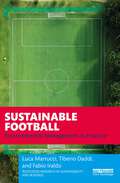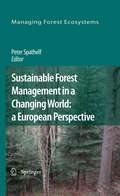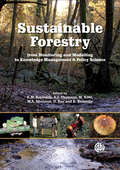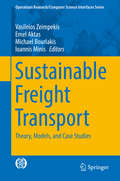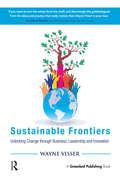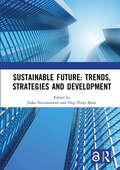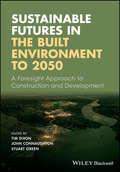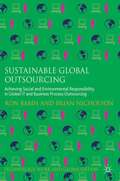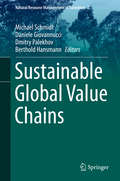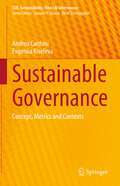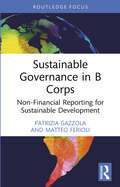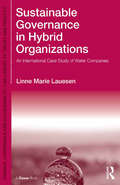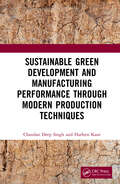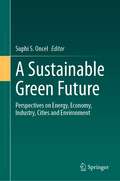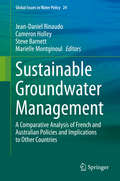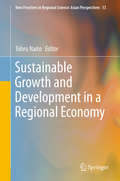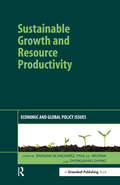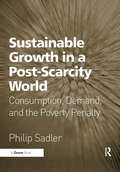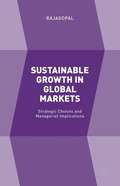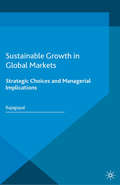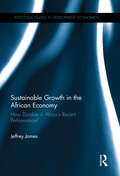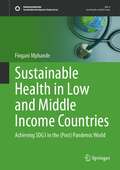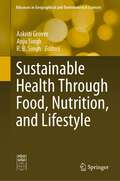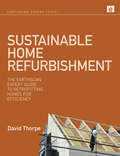- Table View
- List View
Sustainable Football: Environmental Management in Practice (Routledge Research in Sustainability and Business)
by Luca Marrucci Tiberio Daddi Fabio IraldoThis book provides a comprehensive, up-to-date overview of the different environmental strategies adopted in the football world to foster sustainability. The authors lay out useful insights, both for scholars and practitioners, to improve good governance in football organisations by empowering environmental organisational and operational actions. As well as examining practical methods of implementing green initiatives, the book discusses their added value from different perspectives including football fans, football managers and policymakers. By identifying the most important green actions for the dissemination of environmentally friendly behaviours at both individual and organisational levels, the book demonstrates how football organisations can use operational and organisational methods to develop an environmental sustainability strategy. The book contributes to developing the role of the football world by covering different facets of sustainability such as the circular economy, climate change, green marketing, fans engagement and more. It will be a valuable resource for scholars and students of environmental management, sustainable business and corporate social responsibility, as well as professionals working in the football industry.
Sustainable Forest Management in a Changing World: A European Perspective (Managing Forest Ecosystems #19)
by Peter SpathelfYet another book on the topic of ‘Sustainable Forest Management’ can only be justified by new information that is of direct relevance. The contents of this volume concentrate on the very latest factors and developments, thus, hopefully, contributing both to the book’s attractiveness and to closing gaps in the discipline’s database. This book is written for researchers in the field of forest management, international forestry, and climate change-related issues, legal and policy advisors, as well as for managers of private companies who deal with SFM. The authors of the various sections are scientists in the field of forestry and other environmental sciences. They represent different institutions, mainly universities and research agencies in Germany, but also high-level international institutions in development co-operation, such as the World Bank, FAO, and IIASA. The scope of the book is to refresh the meanings and perceptions of SFM against the background of the rapid changes in our natural and social environment. Climate change and the rapid increase of atmospheric CO concentration is a global process 2 with negative impacts of different kinds, among others on natural ecosystems such as forests. A crucial issue therefore is how forest management can contribute to forest conservation in light of changing climatic conditions. Moreover, policy changes such as the introduction of certification schemes and the new emphasis laid on Non-Wood Forest Products justify the re-evaluation of the role of SFM in delivering ecological goods and services from our forests.
Sustainable Forestry: From Monitoring and Modelling to Knowledge Management and Policy Science
by M. A. Shannon A. J. Thomson K. M. Reynolds M. Kohl D. Ray K. RennollsThis book presents the issues related to both global climate change and conservation of biodiversity. It highlights four methodologies and shows how they contribute in overcoming the ecological challenges facing our world.
Sustainable Freight Transport: Theory, Models, And Case Studies (Operations Research/computer Science Interfaces Ser. #63)
by Vasileios Zeimpekis Emel Aktas Michael Bourlakis Ioannis MinisThis book presents the latest technologies and operational methods available to support sustainable freight transport practices. It highlights market requirements, cutting edge applications, and case studies from innovators in the logistics services industry. The goal is to help bridge the gap between advanced computational techniques and complex applied problems such as those in sustainable transport and logistics operations. Freight transport has traditionally focused on costs and service levels. However, it is no longer possible or socially responsible to neglect the environmental, social, climate, and energy implications of the freight moving globally. This book places sustainability at the forefront of the freight transport agenda. Sustainable Freight Transport: Theory, Models and Case Studies is divided into three sections. Section I focuses on green freight transport policies for air and marine ports. Section II is devoted to using modelling techniques and optimization for achieving sustainable freight transport, while Section III examines policies to support sustainable freight transport practices in urban areas. The contributions come from authors from different areas, backgrounds, and countries to cover a global perspective.
Sustainable Frontiers: Unlocking Change through Business, Leadership and Innovation (Business Frontiers Ser.)
by Wayne VisserSustainable Frontiers throws down the gauntlet to business to step up and be the catalyst for a sustainable future. It presents eight keys to unlocking transformational change – through leadership, enterprise, innovation, transparency, engagement, responsibility, integration and future-fitness. Far from being another tame review of corporate social responsibility and sustainable business initiatives, the book dispels the myths of sustainability and challenges us to let go of old systems that are failing to deliver economic, social and environmental transformation. Sustainable Frontiers gets to the heart of why the sustainability and CSR movements have failed in the past and offers a new view of how sustainable business practices can shape-shift to make a genuine difference inside and outside organisations. The book gathers together experiences from across the globe and shows to the reader what can be achieved with the right vision and leadership. Expect to be challenged, engaged and inspired to join the revolution on the sustainable frontier.Making a successful transition to a more sustainable future depends on letting go. Sustainable Frontiers shows how we must find ways to let go of an industrial system that has served us well, but is no longer fit for purpose. How we will need to let go of old styles of leadership and out-dated models of business, high-impact lifestyles and selfish values. How we must learn to let go of cherished ideologies that are causing destruction and beliefs about ways to tackle problems that are failing to resolve crises.If we are to reach sustainable frontiers, it must begin with changing our collective minds - and only then will we change our collective behaviour. How we accomplish such a global mind-shift is the subject of Sustainable Frontiers. And it starts by admitting that those of us at the vanguard of the sustainability revolution also have to change. We will also have to let go of cherished beliefs and strategies that are not working - starting with the way we communicate our vital, life-saving mission.
Sustainable Future: Proceedings of the 3rd Conference on Managing Digital Industry, Technology and Entrepreneurship, (CoMDITE 2022), Bandung, Indonesia, 24 May 2022
by Siska Noviaristanti Ong Hway BoonThe book contains a selection of papers that were presented at the 3rd Conference in Managing Digital Industry, Technology and Entrepreneurship (3rd CoMDITE) with the theme: Sustainable Future: Trends, Strategies and Development. The Millennium Development Goals, continued as Sustainability Development Goals (SDGs), are effective instruments and have, in recent years, brought many positive changes in numerous countries around the world. Most notably, it has fundamentally changed our way of approaching the tangled set of challenges: States today undertake to achieve concrete development goals; transparency and accountability to citizens and the global public has become a matter of course; and cooperation between the political, economic and societal spheres is no longer questioned. However, in addition to the global pandemic situation it has challenged the business world to develop an outstanding strategy to face extreme uncertainty. Using digital technology and its advancement is believed to be one of the main keys for taking up this challenge.The 3rd Conference in Managing Digital Industry, Technology and Entrepreneurship (the 3rd CoMDITE) has brought forward discussions on implementation of digital technology in strategic, operation, finance, marketing, human resources management, and entrepreneurship around sustainable future issues.The Open Access version of this book, available at http://www.taylorfrancis.com, has been made available under a Creative Commons Attribution-Non Commercial-No Derivatives (CC-BY-NC-ND) 4.0 license. Funded by Telkom University, Indonesia.
Sustainable Futures in the Built Environment to 2050: A Foresight Approach to Construction and Development
by Tim Dixon John Connaughton Stuart GreenBrings together leading thinking on issues of new professional practice and on the future of a sustainable built environment This book focuses on both construction and development issues, and examines how we can transition to a sustainable future by the year 2050—bringing together leading research and practice at building, neighbourhood, and city levels. It deftly analyses how emerging socio-economic, technological, and environmental trends will influence the built environment of the future. The book covers a broad spectrum of interests across the scales of buildings, communities and cities, including how professional practice will need to adapt to these trends. The broader context is provided by an analysis of emergent business models and the changing requirements for expert advice from clients. Sustainable Futures in the Built Environment to 2050: A Foresight Approach to Construction and Development features chapters covering: data and trends, including historical data and UK and international case studies; policies and practice related to the field; current state of scientific understanding; key challenges; key technological advances (including disruptive and systemic technological innovations); change issues and critical uncertainties; and future visions. It provides: A strong conceptual framework based on a ‘Foresight' approach Discussion of the key data and trends that underpin each chapter Coverage of both construction and property development Specially commissioned chapters by academics and practitioners A synthesis of the main findings in the book and key insights for the future to 2050 Sustainable Futures in the Built Environment to 2050: A Foresight Approach to Construction and Development is an important book for postgraduate students and researchers, construction, real estate and property development specialists, engineers, planners, architects, foresight and futures studies specialists, and anyone involved in sustainable buildings.
Sustainable Global Outsourcing
by Ron Babin Brian NicholsonThrough a series of case studies and surveys, the authors examine current sustainability trends in outsourcing and recommend how providers should prepare for increasing buyer demands in this area, suggesting buyers and providers can work together to build successful outsourcing relationships through collaborative sustainability projects.
Sustainable Global Value Chains (Natural Resource Management in Transition #2)
by Robert AtkinsonValue chains are a vital part of how our world operates, yet we are only beginning to understand how to make them sustainable. This volume addresses the crux of that challenge by presenting a broad array of options for understanding and managing the complexity of sustainability initiatives that affect, and are also influenced by value chains. Its chapters present diverse perspectives on both political and private sector governance, including governmental regulations and private standards, and embrace the emergent and critical value of innovative approaches to monitoring and evaluating progress. Finally, the volume offers a review of concrete examples for transformation and transition towards more sustainable value chains in selected sectors, including, amongst others, agriculture, forestry, mining, and tourism.
Sustainable Governance: Concept, Metrics and Contexts (CSR, Sustainability, Ethics & Governance)
by Andrea Cardoni Evgeniia KiselevaThe role of governance as a fundamental pillar of sustainability is widely recognized and confirmed by its inclusion in the main ESG issues (environmental social governance). Through the complex role of governance in the context of ESG, research has developed the notion of sustainable corporate governance, i.e., a system based on the integration of shareholder and stakeholder objectives that protects the environment and the broader community. This book provides a sound theoretical definition, a precise measurement system, and best practice examples for the implementation of sustainable corporate governance. It includes theoretical foundations based on stakeholder and institutional theories from different environments and contexts, such as developed and developing economies, large publicly traded companies and SMEs, and family businesses. In addition to explaining the concept theoretically, it uses practical case studies to address the effective integration of sustainable governance into corporate structures. The book provides business students and researchers with an in-depth analysis of the emerging concept of sustainable governance and is valuable for academics as well as corporate and financial market participants.
Sustainable Governance in B Corps: Non-Financial Reporting for Sustainable Development (Routledge Focus on Business and Management)
by Patrizia Gazzola Matteo FerioliThis book aims to develop the theme of non-financial reporting and the necessity of pursuing sustainable development with particular reference to Benefit Corporations and Certified B Corps. The research offers a systematic and exploratory analysis, with the goal of developing a conceptual framework for supporting companies in the achievement of sustainable governance in line with the United Nations’ guidelines for sustainable development. The first chapter reviews the relevant literature and analyzes the concept of sustainable development, focusing on the United Nations’ policies and SDGs. Chapter 2 reviews the relevant literature on corporate social responsibility, describing its evolution from its birth during the Industrial Revolution through to the present day. Chapter 3 focuses on non-financial reporting and emphasizes the need to establish effective social communication with stakeholders that includes environmental, social, and governance (ESG) aspects. Chapter 4 explores the value of Benefit Corporations and Certified B Corps, which are companies that have adopted an innovative business model that combines the need for both corporate social responsibility and profitability. Finally, the last chapter uses examples of Italian fashion B Corps to illustrate how such companies make decisions based on CSR.
Sustainable Governance in Hybrid Organizations: An International Case Study of Water Companies (Finance, Governance and Sustainability)
by Linne Marie LauesenIn Sustainable Governance in Hybrid Organizations the author Linne Marie Lauesen explores how businesses that have succeeded in conducting sustainable governance, manage and govern their sustainable performance: in other words, how they manage to be economically, socially, and environmentally sustainable. In this respect, hybrid organizations that are formed as businesses with a mission to be sustainable and to provide services for society - such as water companies - are a good point of departure. Water companies are highly regulated whilst working primarily for the betterment of society and on behalf of generations to come, for whom clean and plentiful water and the preservation of nature is a must. Linne Marie has dug deep into these types of hybrid organizations in order to reveal which mechanisms of organizational governance for sustainability are at play, and how these organizations manage to balance their triple bottom lines in order to survive financially, socially, and environmentally and make a business out of their conduct. Balancing these three bottom lines in a sustainable way is explained in a clear and accessible way and the juxtaposition between non-profit and for-profit water companies will show how this model can be transferred to other business spheres.
Sustainable Green Development and Manufacturing Performance through Modern Production Techniques
by Chandan Deep Singh Harleen KaurVarious Multiple Criteria Decision-Making (MCDM) techniques in one book: 13 MCDM techniques have been applied, namely, WSM, WPM, WASPAS, GRA, SMART, CRITIC, ENTROPY, EDAS, MOORA, AHP, TOPSIS, VIKOR, and new tools: MDEMATEL, Fuzzy MDEMATEL, Modified Fuzzy TOPSIS and Modified Fuzzy VIKOR. To date, no other book possesses this many tools. Various quantitative techniques: Different quantitative techniques have been applied, namely, Cronbach alpha, Chi-square and ANOVA (for demographic analysis), Percent Point Score and Central Tendency (response analysis), Factor Analysis, Correlation and Regression. To date, no other book possesses this many tools. Interpretive Structural Modelling: ISM has been applied for verifying MCDM results through MICMAC analysis and ISM model thus paving the way for model through SEM. Structural Equation Modelling: SEM using AMOS in PASW has been applied for model development. New MCDM techniques developed: In the process during qualitative analysis, new tools have been developed and their results have been compared with other existing MCDM tools and the results are encouraging. The new techniques are MDEMATEL, Fuzzy MDEMATEL, Modified Fuzzy TOPSIS and Modified Fuzzy VIKOR. Qualitative Model Developed: As the title says, Sustainable Green Development and Manufacturing Performance through Modern Production Techniques. It is a need-of-the-hour topic, as industries must maintain their performance (sustainable development) and, while sustaining, they have to keep in mind green issues (that is, environment-related issues, especially during the COVID-19 pandemic) and adopt advanced manufacturing and maintenance techniques. A model for this has been developed which will be helpful to both academicians and industrialists. Real-time Case Studies: Case studies in two industries of differing origins, different manufacturing sectors, different products, and comparing their units in the country of their origin and India. Dr. Chandan Deep Singh is an assistant professor in the Department of Mechanical Engineering, Punjabi University, Patiala, Punjab (India). He is a co-author of Adolescents, Family and Consumer Behaviour (Routledge, 2020) and of Manufacturing Competency and Strategic Success in the Automobile Industry (CRC Press, 2019). Dr. Harleen Kaur is a manager (HR) at DELBREC Industries, Pvt. Ltd., Chandigarh. She co-authored Adolescents, Family and Consumer Behaviour (Routledge, 2020).
A Sustainable Green Future: Perspectives on Energy, Economy, Industry, Cities and Environment
by Suphi S. OncelThe aim of this book is to open a vision to sustainability and development through a holistic perspective comprising the critical blocks of energy, environment and economy. From renewable energy, urban infrastructure, societal health to industrial symbiosis, the book assesses critical issues to reach a green future with realistic solutions proposed by a diverse range of multidisciplinary experts. It is intended for a broad readership of academics, researchers and industry experts focusing on these fields, and with specializations in sustainability. The book is divided into different clusters starting with an introductory foreword to express the theme of the book and the route of the titles. The first cluster of the book highlights various multidisciplinary perspectives considering the interaction between different expertise. From engineering to economy supported with social pillars, this section gives the critical points of selected topics to focus on the future with a sustainability vision. The second cluster focuses on health issues, with discussion about the impacts of the COVID-19 pandemic and the way forward. Critical points like vaccines, health care and food security are highlighted. The third cluster is comprised of titles related to the urban environment and infrastructure. New solutions and discussions on biodesign, waste management and transportation are covered in this section. The last cluster covers energy, and highlights renewable energies such as bioethanol, biogas and wind.
Sustainable Groundwater Management: A Comparative Analysis of French and Australian Policies and Implications to Other Countries (Global Issues in Water Policy #24)
by Steve Barnett Jean-Daniel Rinaudo Cameron Holley Marielle MontginoulThis book describes and analyses the diversity of possible approaches and policy pathways to implement sustainable groundwater development, based on a comparative analysis of numerous quantitative management case studies from France and Australia.This unique book brings together water professionals and academics involved for several decades in groundwater policy making, planning or operational management to reflect on their experience with developing and implementing groundwater management policy. The data and analysis presented accordingly makes a significant contribution to the empirical water management literature by providing novel, real world insights unpublished elsewhere. The originality of the contributions also lies in the different disciplinary perspectives (hydrogeology, economics, planning and social sciences in particular) adopted in many chapters. The book offers a unique comparative analysis of France, Australia and experiences in countries such as Chile and the US to identify similarities, but also fundamental differences, which are analysed and presented as alternative policy options – these differences being mainly related to the role of the state, the community and market mechanisms in groundwater management.
Sustainable Growth and Development in a Regional Economy
by Tohru NaitoThis is the first book to provide readers with a theoretical and empirical analysis of sustainable economic growth in Asian countries. Recently, most Asian countries have achieved rapid economic growth and their existence cannot be ignored in the world economy. However, these countries now face the serious problems that have confronted more developed countries such as environmental problems, social security and unemployment. Rapid economic growth has brought environmental pollution, regional disparities, and serious congestion due to insufficient infrastructure. Thus, it is necessary to understand the background economic mechanism in order to find the prescription for each problem. This book is intended not only for the researcher but also for the policy maker, for both of whom it provides the basic methods for analyzing regional problems from the points of view of endogenous economic growth theory, environmental economics, and spatial economics. This work presents theoretical as well as empirical analyses. Particularly, we cite the examples of Asian countries: Japan, China, Korea, Thailand and others. The aim is for readers to apply the theories in this book to the above-mentioned problems in Asian countries as an aid in policy making. The authors are specialists in macroeconomics, public economics, environmental economics, transportation economics and spatial economics, all of which are important aspects of regional science.
Sustainable Growth and Resource Productivity: Economic and Global Policy Issues
by Raimund Bleischwitz Paul J.J. Welfens Zhongxiang ZhangWritten by international experts in their respective fields, Sustainable Growth and Resource Productivity provides a comprehensive overview of global issues of raw materials supply and resource use. It also introduces new views and perspectives on the sustainable growth of emerging economies and develops a rationale for a new resource economics. This book emphasises why resources are back on the agenda: firstly, because of their fundamental economic role in technological progress and long-term prosperity; secondly, because deficits in raw material markets are now intertwined with deficits in the financial markets; and, thirdly, because the sustainable management of natural resources is a crucial element in responses to new global challenges such as climate change. Sustainable Growth and Resource Productivity analyses raw materials supply and resource use in a global context. The contributions present state-of-the-art results and perspectives on the availability of resources and discuss factors such as limited supply, demand from emerging and other economies and the critical shortage of some materials – particularly some metals – that are essential inputs in many high-tech processes and may put certain industries at risk. Sustainable Growth and Resource Productivity sheds new light on the economics of sustainable growth. Linking the current financial crisis with stock market pricing and innovation dynamics, it argues for reforms in international macro-economic policies. It also critically discusses the implications of valuing labour productivity over capital and resource productivity and argues that policies favouring capital productivity will increase both social and economic sustainability. Further contributions are made on the business dimensions of material efficiency as well as on policy recommendations. The book examines the overall empirical trend towards decoupling resource use from economic growth. It undertakes a rigorous cross-country comparison and looks in more detail at the cases of Finland and Greece, as well as at emerging economies and their role in the global governance of natural resources. A key focus is placed on China, with discussion of recent findings regarding Chinese domestic policy on energy, climate and resources as well as on developing Chinese foreign policy in Africa. The book concludes with the positing of a new theory of resource economics: an emerging sub-discipline that puts resources at its heart but clearly aligns with other fields of economics, and transcends the borderlines of geology, geography, material science, recycling and waste, as well as elements of other social sciences. This important new book will be essential reading for economic researchers, governmental officials, businesses and NGOs with an interest in understanding the policy links to sustainable growth and in learning more about the emerging field of resource productivity.
Sustainable Growth and the Interdependence of Financial Goals and Policies
by David W. Mullins Jr.Demonstrates the interaction of product market and capital market goals.
Sustainable Growth in a Post-Scarcity World: Consumption, Demand, and the Poverty Penalty
by Philip SadlerOver 20 years ago Philip Sadler, then head of a leading British business school, wrote Managerial Leadership in the Post-Industrial Society. In it he predicted that business would experience the most radical transformation since the Industrial Revolution of the 19th century. This transformation has now taken place. In his latest book, Sustainable Growth in a Post-Scarcity World, Sadler charts developments once envisaged by Keynes, Chase, Galbraith and Packard, and more recent radical thinkers such as Chris Anderson. Sadler describes how many goods and services have moved from relative scarcity to relative abundance, and asks how this trend can be reconciled with the global issues of population growth and climate change. He assesses the impact of new technologies, new energy sources, new materials and the development of artificial intelligence, on business, government and economics, and discusses the challenges ahead - the creation of new business models, the need to meet people's legitimate expectations of improved living conditions while avoiding environmental catastrophe, and the need to adapt ideas developed in scarcity to conditions of abundance. Why is it that in countries foremost in creating post-scarcity conditions, millions are still in poverty, and billions, worldwide, still lack basic necessities of life? Philip Sadler agrees with those who say the relief of global poverty cannot rely on aid and corporate philanthropy. He explores the idea of re-engineering products and delivering them into bottom-of-the-pyramid (BOP) markets, and concludes that the more global companies take this route, as some are already doing, the more profitable they will find it, and this will in turn help the poorest people who currently pay more for goods and services - the 'poverty penalty' - than the rich.
Sustainable Growth in Global Markets: Strategic Choices and Managerial Implications
by RajagopalSustainable Growth in Global Markets provides a comprehensive introduction to the concept of market and business management outside the domestic market. It covers complex elements of market management, analysing behavioural theories such as theory of comparative advantage, theories of macro and micro marketing economics, socio-cultural theories, and various contemporary concepts of international business management. The book puts forward a broad foundation of the subject beginning with a discussion of the concept of market dynamics and followed by an analysis of the changing behaviour of markets and its components. The core discussion focuses upon the ability to do business in international markets, putting forward critical insights on the significance of leadership, building consumer value through innovation, tracking the external environment for organizational change as well as important emerging trends towards building an innovative venture.
Sustainable Growth in Global Markets: Strategic Choices and Managerial Implications
by RajagopalSustainable Growth in Global Markets provides a comprehensive introduction to the concept of market and business management outside the domestic market. It covers complex elements of market management, analysing behavioural theories such as theory of comparative advantage, theories of macro and micro marketing economics, socio-cultural theories, and various contemporary concepts of international business management. The book puts forward a broad foundation of the subject beginning with a discussion of the concept of market dynamics and followed by an analysis of the changing behaviour of markets and its components. The core discussion focuses upon the ability to do business in international markets, putting forward critical insights on the significance of leadership, building consumer value through innovation, tracking the external environment for organizational change as well as important emerging trends towards building an innovative venture.
Sustainable Growth in the African Economy: How Durable is Africa’s Recent Performance? (Routledge Studies in Development Economics)
by Jeffrey JamesThe current growth path in sub-Saharan Africa is not following the Lewis model where labour moves from low-productivity agriculture to higher productivity manufacturing. Instead, it is moving directly to inappropriate (import and labour-saving) methods. This book seeks to show how this distorted growth process leaves out the major resource of these countries – labour – and ends up creating unstable employment and underemployment, leading to inequality and poverty. In this way it demonstrates how the entire growth process may be rendered unstable and unsustainable. Sustainable Growth in the African Economy considers whether the relatively rapid growth of recent years can be maintained or improved upon, with a focus on the process of industrialisation. Basing itself on a well-known dual-economy model, the proposed book focuses on several major problems of industrialisation, which has long been seen as the means of structural change in an economy which begins from a low income level. The book considers how the future trajectory of sub-Saharan Africa compares to recent success stories on other continents, and explains how factors such as rapid population growth and capital and import-intensive technology in manufacturing could foreshadow future social and political problems. This book will be essential reading to students and policymakers who are concerned with the existing pattern of African growth.
Sustainable Health in Low and Middle Income Countries: Achieving SDG3 in the (Post) Pandemic World (Sustainable Development Goals Series)
by Fingani MphandeThis book highlights lessons from the COVID-19 pandemic and explains how these can be used to build sustainable health systems, especially in Low- and Middle-Income Countries (LMIC). It investigates the impact of outbreak response and management on health sustainability in LMIC from the perspective of SDG3: “Ensuring healthy lives and wellbeing for all at all ages”. Despite strides being made in some areas for SDG target 3.3 to fight communicable diseases, the COVID-19 pandemic has caused interruptions that will considerably affect vaccination coverage as well as the progress that was made, for example: in reducing malaria cases. Vulnerable populations who were already struggling to access their healthcare needs before the pandemic may face even greater challenges at present and in the years to come, post-pandemic. This book considers the progress on attaining the SDG3 targets, specifically: to improve early warning systems for management of national and global health risks, and the effect of pandemics - including but not limited to the COVID-19 pandemic - and emerging disease outbreaks. It explores the weaknesses and strengths in LMIC and how to strengthen capacities in these countries. The author also investigates and proposes approaches that can, or should, be implemented to ensure sustainable health systems in developing countries, including early warning systems, risk reduction, and the management of global and national health risks. This book is of great interest to public health professionals, infectious diseases experts, and epidemiologists, as well as students and researchers of public health systems and healthcare infrastructure in developing countries.
Sustainable Health Through Food, Nutrition, and Lifestyle (Advances in Geographical and Environmental Sciences)
by Aakriti Grover Anju Singh R. B. SinghThis book uncovers the multiple layers of challenges posed to achieve sustainable human health and improves the understanding of interactive areas set by the UN Sustainable Development Goals (1) no poverty, (2) zero hunger, (3) good health and wellbeing, (6) clean water and sanitation, and (11) sustainable cities and communities. The book focuses on conceptual understanding, food, nutrition, lifestyle, and their integration to reinforce the ideas of holistic health principles.' The most important drivers of sustainable health are food, nutrition, and lifestyle. Healthy food is a basic need of human beings. In under-developed regions, people are underweight and facing malnutrition, with a prevalence of deficiency diseases due to low intake of micro-nutrients such as vitamin A, iodine, and protein among others. A good diet as well as lifestyle has a tremendous bearing on a person’s health, emotional stability, and enthusiasm for life. The global coronavirus pandemic has brought unimaginable devastation and hardship in all corners of the globe, questioning the existing healthcare services, health policies, and health planning across the developed and developing countries. It has also exposed the lacunae in understanding health, the base of human happiness. The global community needs to gravely ponder the health issues we are facing and explore sustainable solutions for health recovery and the wellbeing of humanity.
Sustainable Home Refurbishment: The Earthscan Expert Guide to Retrofitting Homes for Efficiency (Earthscan Expert)
by David ThorpeA retro-fit offers many benefits: cutting electricity and heating bills, increasing the resale value of homes, slashing carbon emissions and creating a healthier place to live. This book is the guide to making it happen. It looks at: draught-proofing, insulation and damp ventilation, heating and cooling electrical efficiency and renewable energy water use and re-use materials' life cycles and incorporating nature protection from climate change impacts - modelling energy flows and embodied energy how we can meet the need to cut carbon emissions from dwellings by eighty percent by 2050. Projects can apply to apartment blocks, recent builds and older, solid-walled properties. Enlivened with helpful diagrams and photographs, plus plenty of pointers for further information, it provides a comprehensive resource handbook for any building professional and contractor, students – or any homeowner serious about efficiency (cash and carbon) savings.
